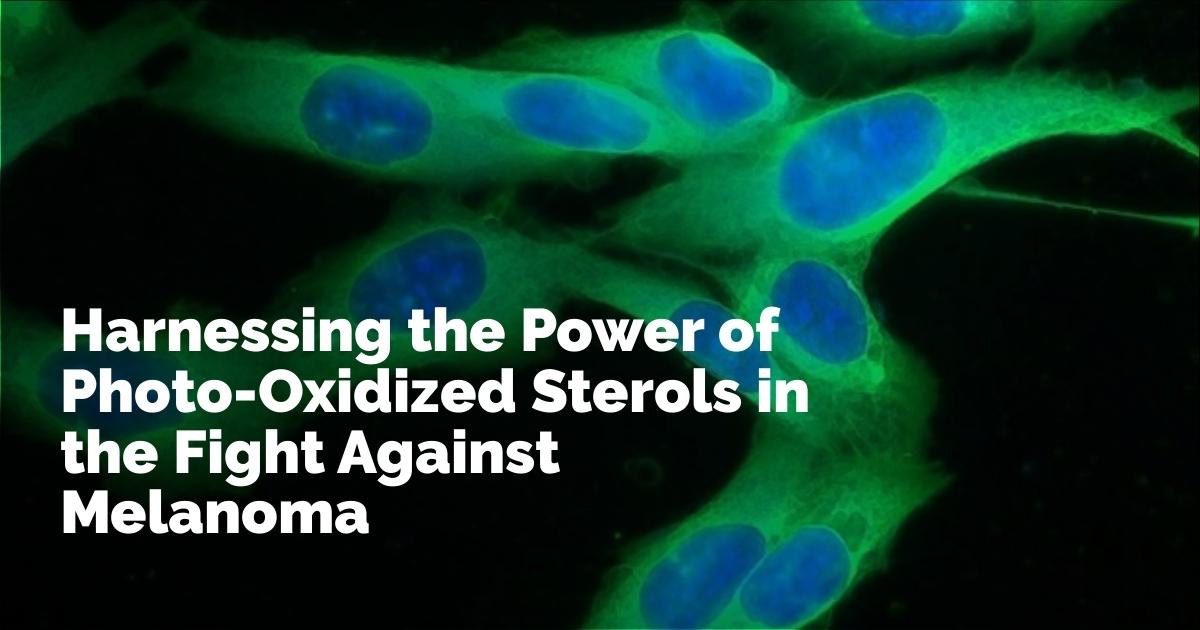Research Explores the Role of Photo-Oxidized Sterols in Killing Melanoma Cells
Melanoma: A Lurking Threat
Melanoma stands as the most aggressive form of skin cancer. Despite its rarity compared to other skin cancers, it is notably serious due to its high metastasis potential. A major risk factor for developing melanoma is prolonged exposure to ultraviolet (UV) rays, which, despite sun's health benefits, induces oxidative stress and inflammation in skin cells through photo-oxidation reactions. This oxidative damage becomes a primary concern when it leads to cell transformation and subsequent cancerous growth.
Light-Induced Reactions and Photodynamic Therapy
In the skin, ultraviolet and even visible light can activate photosensitizers—naturally occurring substances in tissues. This activation is part of a process that converts light energy into chemical energy, creating reactive oxygen species. These reactive entities inflict damage on essential biomolecules, such as the lipids that form cell membranes. However, the destructive power of this photo-oxidation also offers a therapeutic avenue through photodynamic therapy (PDT). PDT is a treatment approach that harnesses light-induced reactions to selectively target and destroy tumor cells or pathogens, offering a less invasive alternative to conventional methods like surgery.
Innovative Research at Redoxoma
A promising development comes from the Center for Research on Redox Processes in Biomedicine (Redoxoma) at the University of São Paulo. Researchers here are investigating the potential of oxidizing compounds, specifically in combination with photodynamic therapy, to develop new strategies to combat melanoma effectively. This coordination of light-enhanced oxidation and PDT could bring forth novel treatments with improved efficacy and reduced invasiveness.
The study led by Professor Sayuri Miyamoto at the University of São Paulo's Institute of Chemistry highlights a breakthrough in understanding how certain lipid oxidations can trigger melanoma cell death. Published in the journal Photochemistry and Photobiology, the investigation examines endoperoxides derived from the oxidation of ergosterol and 7-dehydrocholesterol (7-DHC), both belonging to the sterol class of lipids known for their presence in cell membranes.
The Challenge of Melanoma Progression
Melanoma's rapid progression poses significant treatment challenges. Although not the primary treatment option, photodynamic therapy is gaining momentum due to its minimally invasive nature compared to traditional treatments. The focus of this research was to refine photodynamic therapy, requiring a comprehensive understanding of cell membrane dynamics under oxidative stress.
This particular study is part of broader research into light-induced oxidative damage mechanisms targeting cell membranes. Miyamoto's team scrutinized the photo-oxidation impacts on various sterols, comparing how ergosterol types I and II, 7-DHC, and cholesterol influence membrane integrity. The characterization of main oxidation products formed offers insights into these mechanisms, which are crucial for optimizing therapeutic approaches.
Sterols Under Photo-Oxidative Attack
One of the key discoveries of this research is the variance in cell membrane permeability contingent on the type of oxidative damage. Cell membranes, composed of a lipid bilayer intertwined with proteins, are primarily structured by phospholipids. These phospholipids are vulnerable to oxidation, jeopardizing membrane integrity, increasing permeability, and potentially ushering in cell death.
Photo-oxidation reactions bifurcate into two primary mechanisms. Type I involves the production of reactive radical species, such as superoxide radical anions and hydroperoxyl radicals. Meanwhile, Type II reactions yield singlet molecular oxygen, a notably reactive form of oxygen. Findings from this study reveal that sterols, namely ergosterol and 7-DHC, offer superior membrane protection against radical oxidation (Type I) compared to cholesterol. However, under singlet oxygen-mediated oxidation (Type II), cholesterol demonstrates greater effectiveness.
This indicates cholesterol's role as an antioxidant in Type II oxidation contexts. By organizing the cell membrane, it constrains singlet oxygen access to unsaturated lipids, which could otherwise undergo detrimental oxidation. The research demonstrates cholesterol's vital role in shielding cell membranes from light-induced damage.
Probing Into Endoperoxide Stability
In their protective functions, sterols undergo oxidation yielding an array of products, including endoperoxides. The study evidences that endoperoxides derived from 7-DHC and ergosterol are notably stable within these oxidative processes. A previous publication in Nature by Miyamoto's team highlighted 7-DHC's antioxidant capacity in protecting cells from ferroptosis, a type of cell death associated with radical oxidation reactions. However, this protective role involves oxidation and subsequent product formation.
In mammals, 7-DHC is a cholesterol precursor, while ergosterol, although structurally similar to 7-DHC, is predominantly found in yeast. Upon oxidation, ergosterol also generates endoperoxides. Evaluating both these sterols prompted the study's comparative approach to elucidate their respective protective or harmful effects.
Impact on Melanoma Cell Viability
Testing the viability of A375 melanoma cells exposed to 7-DHC, ergosterol, and their respective endoperoxides produced via photodynamic therapy revealed compelling results. Remarkably, the oxidized derivatives of ergosterol and 7-DHC, generated by singlet oxygen, proved more effective at eliminating melanoma cells than their precursor molecules. This presents an unprecedented therapeutic pathway, suggesting that precise manipulation of oxidation pathways can enhance PDT efficacy against melanoma.
Future Insights and Research Directions
These findings not only present a novel mechanism for targeting melanoma cells but also pave the way for further research. Subsequent studies will delve into how varying concentrations of endoperoxides and different radiation doses modulate their effects. Such investigations will tackle the questions that this pioneering study has brought to light, potentially leading to groundbreaking advancements in melanoma treatment.
Understanding the intricacies of oxidation pathways in sterols and their implications for cell membrane integrity and cancer cell viability will continue to be a focal point of this research agenda.
출처 : Original Source

